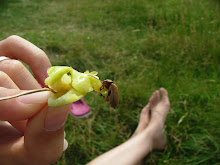CAVES 2005 (1): Reading about the world
Reading about the world:
guided reading for children through non-fiction
by Ian Martin
1. Creating an environment is important: Ss can just pick up a book read anytime.
2. Give variety to reading materials: Boys in elementary schools fairly not like stories; girls do. After moving onto junior high schools, boys’ reading picks up because they are asked to read more non-fiction information books.
3. meaning-focused input: learning a list of words is 1000 times more difficult than reading them in content.
4. To learn a new word: it will take 5 to 10 times (instead of the meaning being taught directly).
5. low frequency words: need general understanding; high frequency words: need to be studied
6. language teaching & study takes: (1) voca & grammar (2) syntax (eg. pountuations...)
7. A suitable new book to read will contain 1 new word in every 16 words you read. (90% of the voca should already be familiar to the reader)
8. meaning-focused input: to read; meaning-focused output: (1) what Ss remember about the book after reading it? (2) can Ss make sentences by using the new voca they’ve learned
9. language study v.s. fluency development
10. Teaching how to read is not just about making Ss learn “new words”, but to teaching the “meaning”!
11. The structure of a story: a conflict at the beginning, a problem in the middle, and a resolution in the end. (A purpose of a story is to create the need to read.)


2 Comments:
Great recap. Have you done any of this in the classroom?
aiden
Can you make it on June 25th?
Let me know when I can drop off the camera, ok?
How are things at garden?
aiden
Post a Comment
<< Home